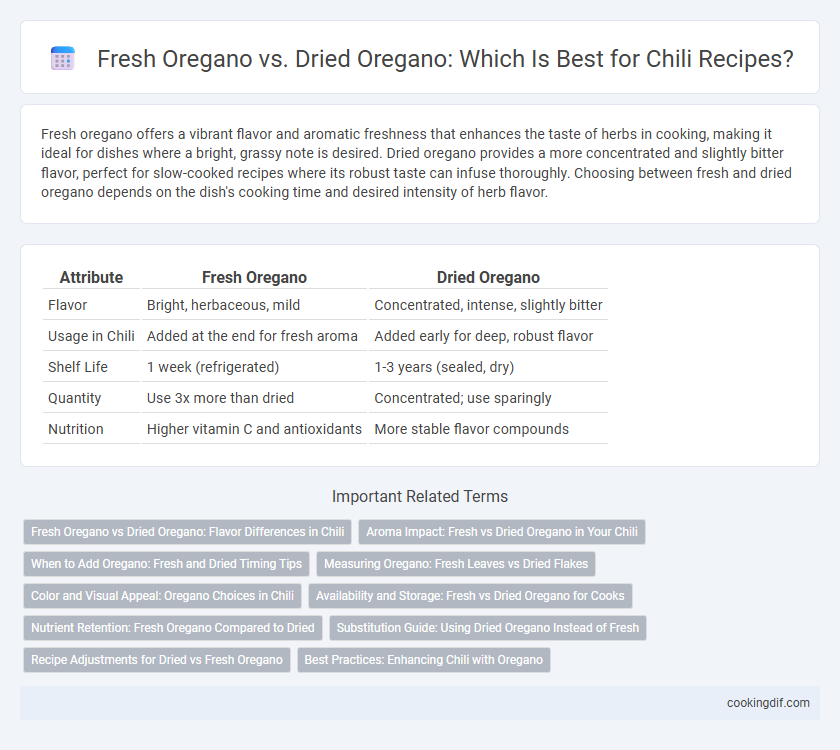Fresh oregano offers a vibrant flavor and aromatic freshness that enhances the taste of herbs in cooking, making it ideal for dishes where a bright, grassy note is desired. Dried oregano provides a more concentrated and slightly bitter flavor, perfect for slow-cooked recipes where its robust taste can infuse thoroughly. Choosing between fresh and dried oregano depends on the dish's cooking time and desired intensity of herb flavor.
Table of Comparison
| Attribute | Fresh Oregano | Dried Oregano |
|---|---|---|
| Flavor | Bright, herbaceous, mild | Concentrated, intense, slightly bitter |
| Usage in Chili | Added at the end for fresh aroma | Added early for deep, robust flavor |
| Shelf Life | 1 week (refrigerated) | 1-3 years (sealed, dry) |
| Quantity | Use 3x more than dried | Concentrated; use sparingly |
| Nutrition | Higher vitamin C and antioxidants | More stable flavor compounds |
Fresh Oregano vs Dried Oregano: Flavor Differences in Chili
Fresh oregano offers a vibrant, slightly citrusy flavor that enhances the brightness of chili dishes, while dried oregano provides a more concentrated, earthy taste with subtle bitterness. The volatile oils responsible for fresh oregano's aromatic profile diminish during drying, making dried oregano more suitable for slow-cooked chili recipes where its intensity can infuse gradually. Using fresh oregano is ideal for finishing chili or adding at the end to preserve its delicate herbal notes, whereas dried oregano delivers robust flavor when incorporated early in the cooking process.
Aroma Impact: Fresh vs Dried Oregano in Your Chili
Fresh oregano delivers a vibrant, citrusy aroma that enhances the depth of chili with bright, herbaceous notes, while dried oregano offers a more concentrated, earthy scent that intensifies over cooking time. The volatile oils in fresh oregano provide immediate fragrance, making it ideal for finishing dishes, whereas dried oregano releases flavor gradually, blending seamlessly during slow simmering. Choosing between fresh and dried oregano affects the overall aromatic profile, influencing how the chili's spices and ingredients harmonize.
When to Add Oregano: Fresh and Dried Timing Tips
Fresh oregano releases its vibrant, citrusy flavor best when added near the end of cooking chili, preserving its aromatic oils and bright notes. Dried oregano requires earlier incorporation, typically during the simmering process, to allow its robust, earthy essence to fully infuse the chili. Timing the addition based on oregano form enhances the overall herb complexity and depth of chili dishes.
Measuring Oregano: Fresh Leaves vs Dried Flakes
Measuring oregano requires different approaches for fresh leaves and dried flakes, with fresh oregano typically used at a 3:1 ratio when substituting dried oregano. Fresh oregano leaves contain more moisture, making them less concentrated in flavor compared to dried oregano flakes, which are more potent and compact. For accurate seasoning in chili recipes, one tablespoon of fresh oregano leaves equals approximately one teaspoon of dried oregano flakes.
Color and Visual Appeal: Oregano Choices in Chili
Fresh oregano in chili offers vibrant green leaves that enhance the dish's visual appeal with a lively and natural color, while dried oregano provides a muted, darker green to brown shade that blends subtly into the chili. The bright appearance of fresh oregano can make chili presentations more appetizing and visually stimulating, contrasting with the rustic and earthy tones added by dried oregano. Chefs often prefer fresh oregano for garnishing to boost color vibrancy, whereas dried oregano is chosen for deeper flavor integration without significantly altering the chili's visual palette.
Availability and Storage: Fresh vs Dried Oregano for Cooks
Fresh oregano offers a vibrant flavor but is highly perishable, requiring refrigeration and consumption within one to two weeks, making it less accessible in some regions. Dried oregano provides extended shelf life of up to six months when stored in airtight containers away from light and moisture, offering consistency and convenience for cooks. Availability of dried oregano in most grocery stores worldwide ensures a reliable supply, while fresh oregano's seasonal and regional limitations affect its accessibility.
Nutrient Retention: Fresh Oregano Compared to Dried
Fresh oregano retains higher levels of vitamin C and essential oils compared to dried oregano, contributing to greater antioxidant capacity and flavor potency. The drying process reduces moisture content and can degrade sensitive nutrients such as vitamin C and certain volatile compounds, resulting in lower nutrient density. In culinary applications, fresh oregano offers enhanced nutritional benefits alongside a more vibrant aroma, making it preferable for recipes emphasizing health and flavor.
Substitution Guide: Using Dried Oregano Instead of Fresh
Dried oregano is more concentrated than fresh oregano, so when substituting, use one-third the amount of dried for an equal quantity of fresh. The flavor of dried oregano intensifies during cooking, making it ideal for slow-simmered dishes like chili. To maximize aroma, crush dried oregano between your fingers before adding it to your recipe.
Recipe Adjustments for Dried vs Fresh Oregano
Dried oregano offers a more concentrated flavor than fresh oregano, so when substituting dried for fresh in chili recipes, reduce the amount by one-third to avoid overpowering the dish. Fresh oregano's bright, herbal notes enhance chili with subtle complexity, making it ideal for recipes where a lighter, fresher taste is desired. Adjust cooking times accordingly; dried oregano develops flavor during longer simmering, while fresh oregano should be added toward the end to preserve its delicate aroma.
Best Practices: Enhancing Chili with Oregano
Fresh oregano delivers a vibrant, citrusy flavor that brightens chili, making it ideal for finishing dishes or adding near the end of cooking to preserve its aromatic oils. Dried oregano offers a more concentrated, earthy taste that infuses well during long simmering, enhancing chili's depth and complexity. Best practice involves combining both forms: start with dried oregano to build a robust base and finish with fresh oregano for a fresh, herbaceous lift.
Fresh oregano vs dried oregano for herbs Infographic

 cookingdif.com
cookingdif.com